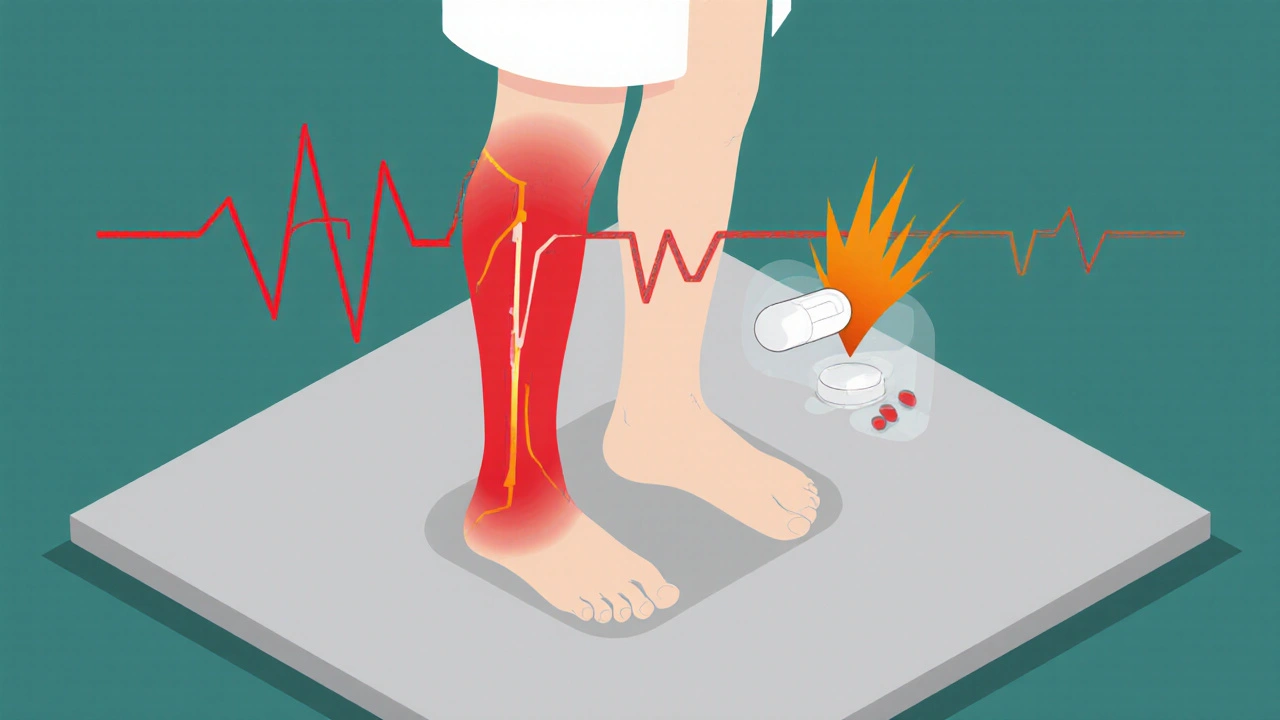Fluoroquinolone Comparison Tool
Compare key attributes of Lquin (Levofloxacin) and other fluoroquinolones including spectrum, typical dosing, common indications, notable side effects, and average cost.
| Antibiotic | Spectrum (Gram +/-) | Typical Adult Dose | Common Indications | Notable Side Effects | Average Cost (US $) |
|---|---|---|---|---|---|
| Lquin (Levofloxacin) | Broad (Gram +, Gram -) | 750 mg once daily | Pneumonia, sinusitis, UTIs, skin infections | Tendon rupture QT prolongation CNS effects | ≈ $30 |
| Ciprofloxacin | Strong Gram -, modest Gram + | 500 mg twice daily | UTIs, intra-abdominal infections, prostatitis | Tendonitis CNS toxicity Photosensitivity | ≈ $20 |
| Moxifloxacin | Broad, excellent atypical coverage | 400 mg once daily | Community-acquired pneumonia, COPD exacerbation | QT prolongation Liver enzyme rise | ≈ $45 |
| Gemifloxacin | Broad, good for COPD flare-ups | 400 mg once daily | Acute bacterial exacerbations of chronic bronchitis | Tendon injury Photosensitivity | ≈ $40 |
| Norfloxacin | Primarily Gram - | 400 mg twice daily | Complicated UTIs, prostatitis | Tendon rupture CNS symptoms | ≈ $15 |
Class-Wide Risks
- Tendon toxicity: sudden pain, swelling, or rupture—most common in the Achilles tendon.
- QT-interval prolongation: can trigger dangerous arrhythmias, especially in patients with existing heart disease or when combined with other QT-prolonging meds.
- Central nervous system effects: anxiety, insomnia, seizures or hallucinations, reported more in older adults.
- Clostridioides difficile infection: heightened risk of severe colitis after any broad-spectrum antibiotic.
Choosing an alternative often means weighing these risks against the infection’s severity. For mild sinusitis, guidelines now recommend amoxicillin or a macrolide instead of levofloxacin.
Insurance formularies typically place levofloxacin at a higher tier than generic ciprofloxacin, which can add $10-$15 to out-of-pocket costs. Moxifloxacin and gemifloxacin are usually brand-only and sit at the top of the price ladder. If cost is a primary concern, a generic fluoroquinolone or a non-fluoroquinolone alternative can save a patient up to half the expense.
Quick Checklist
- Confirm the infection requires broad-spectrum coverage—many ear-nose-throat infections respond to amoxicillin.
- Screen for risk factors: age > 60, steroid use, existing QT prolongation, history of tendon disorders.
- Choose Lquin when once-daily dosing and excellent lung penetration are decisive.
- Prefer ciprofloxacin for uncomplicated urinary tract infections where Gram-- coverage is key.
- Reserve moxifloxacin for atypical pneumonia or when a patient cannot tolerate beta-lactams.
- Discuss side-effect monitoring: advise patients to stop the drug immediately if they feel tendon pain or palpitations.
When a doctor prescribes a fluoroquinolone, you often hear names like Lquin, ciprofloxacin or moxifloxacin. But how do they really stack up? This guide breaks down Lquin (Levofloxacin) against its closest alternatives, looks at where each shines, and points out the hidden pitfalls you should know before you fill the prescription.
What is Lquin (Levofloxacin)?
Lquin is the brand name for Levofloxacin, a third‑generation fluoroquinolone antibiotic. It works by inhibiting bacterial DNA gyrase and topoisomerase IV, which stops bacteria from replicating their DNA. First approved in 1996, Levofloxacin quickly became a go‑to for respiratory, urinary and skin infections because it reaches high concentrations in many tissues.
Key Fluoroquinolone Alternatives
Below are the most common fluoroquinolones that doctors consider alongside Lquin.
- Ciprofloxacin - a second‑generation fluoroquinolone with strong activity against Gram‑negative bacteria.
- Moxifloxacin - a fourth‑generation fluoroquinolone that adds extra coverage for atypical pathogens.
- Gemifloxacin - designed for acute bacterial exacerbations of chronic bronchitis.
- Norfloxacin - an older fluoroquinolone mainly used for urinary tract infections.
Non‑Fluoroquinolone Alternatives
Sometimes clinicians skip the whole fluoroquinolone class because of safety concerns. Common substitutes include:
- Doxycycline - a broad‑spectrum tetracycline good for atypical pneumonia and rickettsial diseases.
- Azithromycin - a macrolide that’s often used for community‑acquired pneumonia and certain STIs.
- Amoxicillin - a beta‑lactam antibiotic that remains first‑line for many ear, nose, throat infections.

How Do They Compare? (Table)
| Antibiotic | Spectrum (Gram +/-) | Typical adult dose | Common indications | Notable side effects | Average cost (US$) 10‑day course |
|---|---|---|---|---|---|
| Lquin (Levofloxacin) | Broad (Gram‑ +, Gram‑‑) | 750mg once daily | Pneumonia, sinusitis, UTIs, skin infections | Tendon rupture, QT prolongation, CNS effects | ≈30 |
| Ciprofloxacin | Strong Gram‑‑, modest Gram‑+ | 500mg twice daily | UTIs, intra‑abdominal infections, prostatitis | Tendonitis, CNS toxicity, photosensitivity | ≈20 |
| Moxifloxacin | Broad, excellent atypical coverage | 400mg once daily | Community‑acquired pneumonia, COPD exacerbation | QT prolongation, liver enzyme rise | ≈45 |
| Gemifloxacin | Broad, good for COPD flare‑ups | 400mg once daily | Acute bacterial exacerbations of chronic bronchitis | Tendon injury, photosensitivity | ≈40 |
| Norfloxacin | Primarily Gram‑‑ | 400mg twice daily | Complicated UTIs, prostatitis | Tendon rupture, CNS symptoms | ≈15 |
When to Choose Lquin Over Others
Levofloxacin’s biggest advantage is its once‑daily dosing, which improves adherence for 10‑day courses. It also reaches high concentrations in lung tissue, making it a favorite for moderate‑to‑severe community‑acquired pneumonia (CAP). If a patient needs a single oral dose for a respiratory infection, Lquin often beats the twice‑daily ciprofloxacin schedule.
However, Lquin carries a higher risk of tendon injury in patients over 60, especially those on steroids. In those cases, a shorter‑acting fluoroquinolone like ciprofloxacin-or better yet a non‑fluoroquinolone such as doxycycline-might be safer.
Safety Red Flags Across the Class
All fluoroquinolones share a handful of serious warnings that the FDA still emphasizes:
- Tendon toxicity: sudden pain, swelling, or rupture-most common in the Achilles tendon.
- QT‑interval prolongation: can trigger dangerous arrhythmias, especially in patients with existing heart disease or when combined with other QT‑prolonging meds.
- Central nervous system effects: anxiety, insomnia, seizures or hallucinations, reported more in older adults.
- Clostridioides difficile infection: heightened risk of severe colitis after any broad‑spectrum antibiotic.
Choosing an alternative often means weighing these risks against the infection’s severity. For mild sinusitis, guidelines now recommend amoxicillin or a macrolide instead of levofloxacin.

Cost and Accessibility
Insurance formularies typically place levofloxacin at a higher tier than generic ciprofloxacin, which can add $10‑$15 to out‑of‑pocket costs. Moxifloxacin and gemifloxacin are usually brand‑only and sit at the top of the price ladder. If cost is a primary concern, a generic fluoroquinolone or a non‑fluoroquinolone alternative can save a patient up to half the expense.
Practical Checklist for Clinicians and Patients
- Confirm the infection requires broad‑spectrum coverage-many ear‑nose‑throat infections respond to amoxicillin.
- Screen for risk factors: age >60, steroid use, existing QT prolongation, history of tendon disorders.
- Choose Lquin when once‑daily dosing and excellent lung penetration are decisive.
- Prefer ciprofloxacin for uncomplicated urinary tract infections where Gram‑‑ coverage is key.
- Reserve moxifloxacin for atypical pneumonia or when a patient cannot tolerate beta‑lactams.
- Discuss side‑effect monitoring: advise patients to stop the drug immediately if they feel tendon pain or palpitations.
Bottom Line
Lquin (Levofloxacin) is a solid, once‑daily fluoroquinolone with strong lung and tissue penetration, but it isn’t a universal replacement for every infection. Ciprofloxacin, moxifloxacin, gemifloxacin, and norfloxacin each carve out niches-UTI focus, atypical pneumonia, COPD exacerbations, and cost‑sensitivity, respectively. When safety or price is a concern, turning to doxycycline, azithromycin or amoxicillin can spare patients from the class‑wide warnings.
Frequently Asked Questions
Is Lquin safe for pregnant women?
Levofloxacin is classified as Pregnancy Category C, meaning animal studies showed risk and there are no well‑controlled studies in humans. It should only be used if the benefit outweighs the potential harm, and many clinicians prefer safer alternatives like amoxicillin during pregnancy.
Can I take Lquin with a proton‑pump inhibitor?
Yes, levofloxacin’s absorption is not significantly affected by acid‑suppressing drugs. However, always check for other drug interactions, especially with antacids that contain aluminum or magnesium, which should be spaced at least two hours apart.
How long should I stay on Lquin for a sinus infection?
Current guidelines recommend 5‑7days for uncomplicated acute bacterial sinusitis if the pathogen is known to be susceptible. For more severe cases or resistant organisms, a 10‑day course may be prescribed.
What should I do if I feel tendon pain while taking Lquin?
Stop the medication immediately and contact your healthcare provider. Early discontinuation can prevent a full rupture, and your doctor may switch you to a different class of antibiotic.
Are there over‑the‑counter alternatives to fluoroquinolones for minor infections?
For many mild skin or ear infections, topical antiseptics, bacitracin ointment, or simple analgesics may be enough. Always consult a pharmacist or clinician before self‑treating.








Roger Perez
October 6, 2025 AT 16:18Ever wondered why fluoroquinolones seem to dominate the antibiotic market? 🤔 The broad spectrum of Lquin makes it a convenient one‑dose hero for many lung infections.
Yet, the same potency brings tendon and QT risks that we must respect like a double‑edged sword.
Balancing efficacy with safety is a bit like walking a philosophical tightrope – we seek the good without courting harm.
Stay curious, stay safe, and remember that a well‑chosen alternative can be just as effective! 🌟
michael santoso
October 10, 2025 AT 03:38It is astonishing how laypeople continue to champion levofloxacin as a panacea without acknowledging its inferior pharmacokinetic profile compared to newer agents. The table presented is a rudimentary snapshot that fails to capture the nuanced resistance patterns emerging globally. One would hope clinicians exercise discernment rather than succumbing to marketing hype.
M2lifestyle Prem nagar
October 13, 2025 AT 14:58Levofloxacin works well for severe pneumonia. Watch for tendon pain and stop immediately. Cheap generic options exist for simple UTIs.
Karen Ballard
October 17, 2025 AT 02:18Great overview! The side‑effect section is clear and the cost comparison helps patients make informed choices. 👍 Remember to counsel anyone over 60 about tendon risks and to advise them to report any sudden joint pain.
Gina Lola
October 20, 2025 AT 13:38Yo, the guide nails the PK/PD differences – Lquin’s once‑daily dosing is a real game‑changer for adherence, especially in outpatient CAP. Still, the QT prolongation flag is a red alert for anyone on anti‑arrhythmic meds.
Leah Hawthorne
October 24, 2025 AT 00:58I appreciate the side‑effect checklist; it’s practical for both prescribers and patients. It’d be useful to add a quick note on drug‑drug interactions, especially with antacids, which can affect absorption.
Brian Mavigliano
October 27, 2025 AT 11:18Why glorify levofloxacin when the fungal kingdom offers safer, cheaper alternatives? The notion that “once‑daily is superior” ignores the profound ecological impact of fluoroquinolones on gut flora – a silent rebellion brewing in our microbiomes.
Emily Torbert
October 30, 2025 AT 22:38I get why doctors love Lquin its convenience but the tendon warnings are scary for older folks we all care about
Rashi Shetty
November 3, 2025 AT 09:58While the comparative table is comprehensive, it is regrettable that the authors omitted discussion of the recent FDA boxed warnings regarding fluoroquinolone‑induced aortic aneurysm. 😒 Prescribers must weigh these severe risks against marginal benefits, particularly in cases where narrow‑spectrum agents suffice.
Queen Flipcharts
November 6, 2025 AT 21:18From a perspective of national health stewardship, indiscriminate use of Lquin jeopardizes our antimicrobial sovereignty. The data underscores the necessity for judicious prescribing to preserve efficacy for future generations.
Yojana Geete
November 10, 2025 AT 08:38Behold the saga of Lquin – a hero torn between life‑saving power and treacherous side‑effects a tragic drama indeed
Jason Peart
November 13, 2025 AT 19:58Hey folks! If you're feeling overwhelmed by the antibiotic jungle, remember you're not alone – we’ve all been through the confusion. Levofloxacin can be a solid choice, but keep an eye on any tendon ache or heart flutter. Talk to your doc, ask questions, and never feel pressured into a med that doesn’t feel right. We’ve got each other's backs! 🌈
Hanna Sundqvist
November 17, 2025 AT 07:18All pharma drugs are a lie.
Jim Butler
November 20, 2025 AT 18:38Esteemed colleagues, the structured comparison presented herein serves as an invaluable tool for optimizing antimicrobial selection. By meticulously evaluating spectrum, dosing convenience, and adverse‑effect profiles, clinicians can tailor therapy to individual patient needs. Moreover, cost considerations remain paramount in ensuring equitable access to effective treatment. Let us champion evidence‑based decision‑making and uphold the highest standards of patient care. 🌟
Ian McKay
November 24, 2025 AT 05:58The table correctly aligns each antibiotic’s dosing schedule; however, note that “once daily” should be hyphenated when used as an adjective (e.g., “once‑daily dosing”).
Deborah Messick
November 27, 2025 AT 17:18It is disconcerting that the author lauds levofloxacin without addressing its contribution to antimicrobial resistance, a grave moral failing in contemporary medicine.
Jolanda Julyan
December 1, 2025 AT 04:38The comparison guide is a useful start for many readers.
It lays out the key differences between levofloxacin and other fluoroquinolones.
However, it does not go deep enough into the resistance issues that are rising worldwide.
Clinicians need to understand that overuse of any fluoroquinolone can lead to hard‑to‑treat infections.
The side‑effect section is clear but could mention the rare but serious aortic aneurysm risk.
Cost is a major factor for patients, especially those without insurance.
Generic ciprofloxacin remains the cheapest option in most formularies.
Some patients may prefer once‑daily dosing for convenience.
Yet convenience should never outweigh safety concerns.
The guide correctly advises screening for tendon risk before prescribing.
It also reminds doctors to check for QT‑prolonging drugs.
In practice, I have seen patients stop levofloxacin after just a few days of tendon pain.
Early discontinuation often prevents a full rupture.
Alternative agents such as doxycycline can be effective for many respiratory infections.
When choosing an antibiotic, always weigh the spectrum against the likely pathogen.
Ultimately, responsible prescribing protects both individual patients and public health.
Kevin Huston
December 4, 2025 AT 15:58Dispensing levofloxacin like candy is a disgraceful display of medical hubris; our nation's health system deserves better than cheap shortcuts that sow resistance.
Amanda Hamlet
December 8, 2025 AT 03:18Look, I’m not a pharmacist but I know enough to tell you that pushing Lquin on every patient is a reckless move that hurts our country’s fight against superbugs.